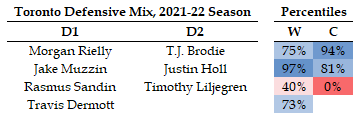Aug 23, 2021
Leafs' core facing 'Last Dance' scenario
In this week’s edition of Seven Questions, Travis Yost asks - if this is a final stand of sorts for the Toronto Maple Leafs core, is this year’s roster deep enough to get over the playoff hump?
By Travis Yost

The eight best regular-season teams in the National Hockey League over the past three seasons have amassed 24 postseason series victories, with two championships to boot.
Within that group resides the Toronto Maple Leafs, our feature team for this week’s edition of Seven Questions. We ask: If this is a ‘Last Dance’ of sorts for the Maple Leafs core, is this year’s roster deep enough to get over the playoff hump?
The mix of eight playoff teams – from the Tampa Bay Lightning through the Maple Leafs – really can be split into two segments. Five of the teams (Tampa Bay, Boston Bruins, Colorado Avalanche, Vegas Golden Knights and Carolina Hurricanes) account for all the playoff success within our elite regular-season group. The Washington Capitals and Pittsburgh Penguins join the Leafs in another segment – three teams who have struck out in the first round of each postseason.
What differentiates Washington and Pittsburgh from Toronto is, of course, championships. Washington had their breakthrough moment in the 2017-18 season, and Pittsburgh has three titles in the Sidney Crosby era. The recent results have been similarly poor, but in the case of these two clubs, the tolerance for those failures is much greater. That’s no longer the case in Toronto.
The Maple Leafs – and general manager Kyle Dubas, more specifically – have opted to bet on an ultra-talented, if top-heavy lineup again this season.
It’s not lost on me that salary cap compression due to the ongoing pandemic probably made that decision for them; one way to maneuver around three players (Auston Matthews, John Tavares and Mitch Marner) commanding 41 per cent of the salary cap on long-term deals is through the annual three per cent cap growth the league has observed for years.
Without cap flexibility and with a pressing need in net, the Maple Leafs have only been allowed to tinker at the margins of their roster. If we look at the expected Maple Leafs depth chart for next season, we see a similarly themed lineup to those of years past – elite offensive options at the top of the lineup and particularly strong down the middle, with some observable weakness in depth positions.
Let’s start with the forward group, using Goals Above Replacement as our production proxy:

This is the core strength of the Maple Leafs – an ultra-productive offence highlighted by tremendous firepower inside the top-six forward group.
Over the past two seasons, the Maple Leafs have scored 3.3 goals per-60 minutes across all situations, good for fourth best in the National Hockey League. It helps that two of the team’s most dangerous scoring weapons are centres on competing lines – even capable defensive teams with shutdown lines have a choice to make between slowing down Matthews and his 146 points over the past two seasons or slowing down Tavares and his 110 points over the same timeframe.
Away from their core strengths, there are two notable items within the forward group.
The first is that we expect meaningful changes to the line combinations, changes we haven’t seen in years past. Nick Ritchie, Alex Kerfoot, and perhaps players like Michael Bunting and Ondrej Kase will get time inside of the top six, a byproduct of displaced minutes from the loss of Zach Hyman and Jared McCann (we hardly knew ye!) this summer.
The second: if there’s risk with this group, it’s the natural top-heaviness of the lineup and the reality that the team is betting on a continuance of strong play from 38-year-old Jason Spezza, and an increasingly elusive bounce-back season from 32-year-old Wayne Simmonds.
Overall, this is a strong forward group that should produce again next season.
Onto the defensive pairings:

We have talked about it being do-or -die time for this Maple Leafs lineup, and perhaps the best example of that is with defenceman Morgan Rielly.
A gifted skater and puck-mover, Rielly is part of a quality first-pairing that gets the Maple Leafs up the ice in a hurry in transition, opening up time and space for the forwards. Another season with big offensive numbers is expected, but I think the Maple Leafs are still trying to figure out what a long-term commitment looks like here – if not because of the challenges through salary cap compression, then because Rielly’s defensive play has held him back just enough from being regarded as an elite first-pairing defender.
The focus area for this group are a collection of depth defenders beyond Rielly, T.J. Brodie, and Jake Muzzin. The organization is playing a bit of a numbers game here, trying to find two quality defenders amidst a mix of Justin Holl, Rasmus Sandin, Timothy Liljegren, and Travis Dermott.
There was a bit of debate over the organization’s decision to protect Holl (subsequently exposing McCann to the Seattle Kraken) – but if nothing else, a combination of what Holl has shown in limited duty and the incredible cost of mid-pair defenders in free agency makes it worth exploring further.
That said, there is downside risk to this group. The NHL is a young man’s league, but the Maple Leafs could have Sandin (21 years old, 37 NHL games) and Liljegren (22, 13 NHL games) in the lineup full time. There isn’t much behind them, and the risk of burdening the Maple Leafs top four over the regular season increases substantially if this theoretical pairing cracks.
That brings us to the goaltenders. Jack Campbell returns, joined by a new face in net in the form of nine-year veteran Petr Mrazek.
Mrazek has had an interesting career – he’s been on a bit of a performance downturn, some the result of injuries, other the result of playing on weaker teams in Detroit and Philadelphia. In Mrazek’s last full season with Carolina (2019-20), we saw slightly below league-average performance.
The shot profiles courtesy HockeyViz:

A prospective Mrazek/Campbell platoon should hold up next season – Campbell has put together two quality seasons together now, perhaps enough to win the majority of starts at the end of next season. But this is not a core strength of the team, and it’s also a group with downside risk. If not because Campbell’s still just 86 games into his professional career, then because of Mrazek’s health and play over the last few years.
This roster should be good enough for the playoffs and beyond, scoring their way out of most problems over the course of the regular season. If the goaltending holds up, this is a Stanley Cup-calibre roster.
If not, this may very well be the last dance for the Maple Leafs’ core.
Data via Natural Stat Trick, NHL.com, Hockey Reference, Evolving Hockey

